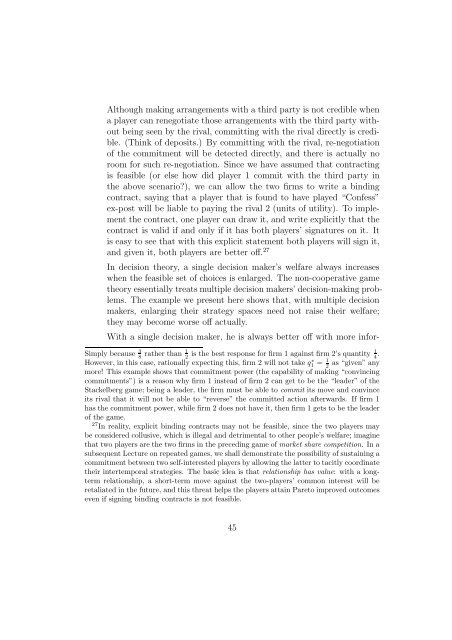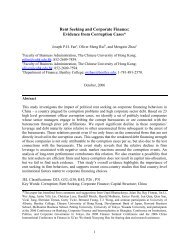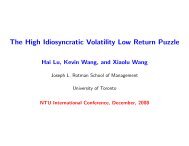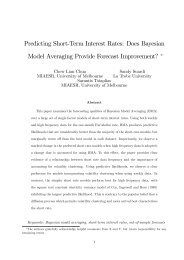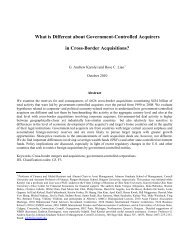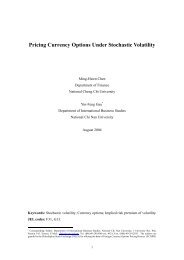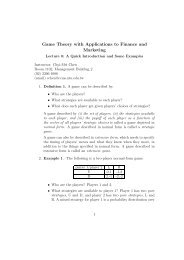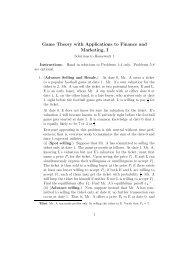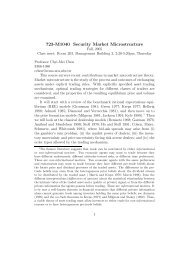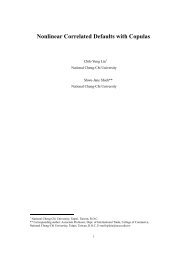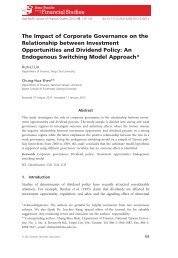Game Theory with Applications to Finance and Marketing
Game Theory with Applications to Finance and Marketing
Game Theory with Applications to Finance and Marketing
You also want an ePaper? Increase the reach of your titles
YUMPU automatically turns print PDFs into web optimized ePapers that Google loves.
Although making arrangements <strong>with</strong> a third party is not credible whena player can renegotiate those arrangements <strong>with</strong> the third party <strong>with</strong>outbeing seen by the rival, committing <strong>with</strong> the rival directly is credible.(Think of deposits.) By committing <strong>with</strong> the rival, re-negotiationof the commitment will be detected directly, <strong>and</strong> there is actually noroom for such re-negotiation. Since we have assumed that contractingis feasible (or else how did player 1 commit <strong>with</strong> the third party inthe above scenario?), we can allow the two firms <strong>to</strong> write a bindingcontract, saying that a player that is found <strong>to</strong> have played “Confess”ex-post will be liable <strong>to</strong> paying the rival 2 (units of utility). To implementthe contract, one player can draw it, <strong>and</strong> write explicitly that thecontract is valid if <strong>and</strong> only if it has both players’ signatures on it. Itis easy <strong>to</strong> see that <strong>with</strong> this explicit statement both players will sign it,<strong>and</strong> given it, both players are better off. 27In decision theory, a single decision maker’s welfare always increaseswhen the feasible set of choices is enlarged. The non-cooperative gametheory essentially treats multiple decision makers’ decision-making problems.The example we present here shows that, <strong>with</strong> multiple decisionmakers, enlarging their strategy spaces need not raise their welfare;they may become worse off actually.With a single decision maker, he is always better off <strong>with</strong> more infor-Simply because 3 8 rather than 1 2 is the best response for firm 1 against firm 2’s quantity 1 4 .However, in this case, rationally expecting this, firm 2 will not take q1 ∗ = 1 2as “given” anymore! This example shows that commitment power (the capability of making “convincingcommitments”) is a reason why firm 1 instead of firm 2 can get <strong>to</strong> be the “leader” of theStackelberg game; being a leader, the firm must be able <strong>to</strong> commit its move <strong>and</strong> convinceits rival that it will not be able <strong>to</strong> “reverse” the committed action afterwards. If firm 1has the commitment power, while firm 2 does not have it, then firm 1 gets <strong>to</strong> be the leaderof the game.27 In reality, explicit binding contracts may not be feasible, since the two players maybe considered collusive, which is illegal <strong>and</strong> detrimental <strong>to</strong> other people’s welfare; imaginethat two players are the two firms in the preceding game of market share competition. In asubsequent Lecture on repeated games, we shall demonstrate the possibility of sustaining acommitment between two self-interested players by allowing the latter <strong>to</strong> tacitly coordinatetheir intertemporal strategies. The basic idea is that relationship has value: <strong>with</strong> a longtermrelationship, a short-term move against the two-players’ common interest will beretaliated in the future, <strong>and</strong> this threat helps the players attain Pare<strong>to</strong> improved outcomeseven if signing binding contracts is not feasible.45


